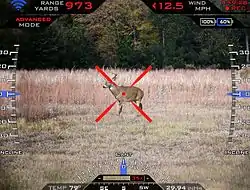TrackingPoint
TrackingPoint is an applied technology company based in Austin, Texas. In 2011, it created a long-range rifle system that was the first precision guided firearm.[1][2]
| Type | Private |
|---|---|
| Industry | Applied technology |
| Founded | 2011 |
| Founder | John McHale |
| Headquarters | , |
| Website | tracking-point.com |
Formed by John McHale in February 2011, the company created its first PGF prototype in March 2011. The company offered its first product in January 2013[3] and a second, the AR Series semi-automatic smart rifle, in January 2014.[4]
Variants of the company's bolt-action rifles use .338 Lapua Magnum and .300 Winchester Magnum ammunition. Semi-automatic variants are available in 7.62 NATO, 5.56 NATO and .300 BLK.
In September 2016, the company began selling the M1400, a squad-level .338 Lapua bolt-action rifle that can hit targets out to 1,400 yards (1,280 m). It can also acquire and hit targets traveling at 20 mph (32 km/h) within 2.5 seconds. The rifle is 45 in (110 cm) long with a 22 in (560 mm) barrel weighing 15.4 lb (7.0 kg). It can be used with the company's ShotGlass wearable glasses that transmits what the scope is seeing to the shooter's eye.[5][6]
In January 2014, the U.S. Army purchased six TrackingPoint fire control systems to begin exploring purported key target acquisition and aiming technologies.[7] The Army has integrated the system onto the XM2010 Enhanced Sniper Rifle for military testing.[8]
In 2018 TrackingPoint introduced the ShadowTrak 6 bolt-action rifle with 6.5mm Creedmoor cartridge that can hit targets out to 1,000 yards (914 m), and can hit targets traveling at 20 mph (32 km/h) in 1 second. Weighing 14.6 lb (6.6 kg), it can fire Hornady ammunition; the 147gr ELD-M (a match type bullet) or the 143gr ELD-X (designed for hunting).
In November 2018, Talon Precision Optics, of Jacksonville, Florida bought TrackingPoint.
Technology


TrackingPoint's precision guided firearms system uses several component technologies:
- Networked Tracking Scope: The core engine that tracks the target, calculates range and the ballistic solution, and works in concert with the shooter and guided trigger to release the shot.[9][10]
- Barrel Reference System: A fixed reference point that enables the networked tracking scope to make adjustments and retain zero over time. The barrel reference system is factory calibrated to a laser reference.[11]
- Guided Trigger: The rifle's trigger is hard-wired to the networked tracking scope. The networked tracking scope controls the trigger weight to eliminate trigger squeeze and shot timing errors.[12]
- Field Software Upgradeable: Software can be uploaded to the scope to add capability.[13]
- Heads Up Display (HUD): The HUD indicates range, wind, reticle, video storage gauge, zoom, and battery life, plus LRF icon, Wi-Fi on/off icon, compass icon, cant wheel, inclination wheels and off-screen indicators.[9][14]
- Recording: An integrated camera captures video and still images from the networked tracking scope and heads up display. Recorded images can be downloaded to a smartphone or tablet from the scope and transmitted via email or social media.[15]
In 2017 computer security experts Runa Sandvik and Michael Auger demonstrated that naive software design left the rifle's aiming computer wide open to remote hacking, when its WiFi capability was turned on.[16] Malicious third parties could disrupt the rifle's accuracy by altering parameters like bullet weight. They showed they could change the bullet weight from 0.4 ounces (11 g) to 72 pounds (33 kg), which would be counted on to make the rifle inaccurate. A skilled hacker would be able to acquire root access, after which they could totally brick the computer, in various ways, like erasing all the computer's software.
References
- Rothman, Wilson (Jan. 10, 2013). “Futuristic Rifle Turns Novice Into Sharpshooter.” NBC News. Retrieved Jan. 20, 2013.
- Murphy, Samantha (Jan. 11, 2013). “TrackingPoint is World’s First Smart Hunting Rifle.” Mashable. Retrieved Jan. 20, 2013.
- “The TrackingPoint Story.” TrackingPoint website. Retrieved Jan. 20, 2013.
- "TrackingPoint Announces New AR Series Rifles" TrackingPoint website. Retrieved March 4, 2014.
- Tracking Point’s New Squad-Level Rifle - Kitup.Military.com, 20 April 2016
- TrackingPoint reveals the M1400 precision-guided firearm - Armyrecognition.com, 22 April 2016
- "Army Testing TrackingPoint Smart-Rifle Tech" - Kitup.Military.com, 27 January 2014
- Army Testing Smart Scope on .300 Win Mag Sniper Rifle - Kitup.Military.com, 14 March 2014
- Takahashi, Dean (Jan. 13, 2013). “TrackingPoint’s Wi-Fi Networked Sniper Scope Can Lock on Targets From Afar and Stream Gun Sight Video.” VentureBeat. Retrieved Jan. 20, 2013.
- Wawro, Alex (Jan. 9, 2013). “The Hunting Rifle of the Future is Here at CES.” PC World. Retrieved Jan. 20, 2013.
- Barrell Reference System. Archived 2013-01-25 at the Wayback Machine TrackingPoint website. Retrieved Jan. 20, 2013.
- Hutchinson, Lee (Jan. 9, 2013). “$17,000 Linux-Powered Rifle Brings ‘Auto-Aim’ to the Real World.” Ars Technica. Retrieved Jan. 20, 2013.
- Higgins, Kilroy (Jan. 9, 2013). “TrackingPoint Shows Off Auto-Aiming Rifle.” Bright Side of News. Retrieved Jan. 20, 2013.
- Curtis, Rob (Jan. 14, 2013). “TrackingPoint Can Turn Your Grammy Into a Deadly Marksman.” Military Times GearScout. Retrieved Jan. 20, 2013.
- Dillow, Clay (Jan. 10, 2013). “The 'Intelligent' Rifle, Now With iPad App, Wi-Fi, Infallible Accuracy.” Popular Science. Retrieved Jan. 20, 2013.
-
Andy Greenberg (2017-07-29). "Hackers Can Disable a Sniper Rifle—Or Change Its Target". Wired magazine. Retrieved 2018-07-27.
The married hacker couple have developed a set of techniques that could allow an attacker to compromise the rifle via its Wi-Fi connection and exploit vulnerabilities in its software.
External links
- TrackingPoint website.
- "Military Science Inspires Better Rifle Control". February 9, 2014.
- Raymond Von Wahlde; Dennis Metz (August 1999). "Sniper Weapon Fire Control Error Budget Analysis" (PDF). United States Army Research Laboratory (published September 9, 1999). Cite journal requires
|journal=(help)
